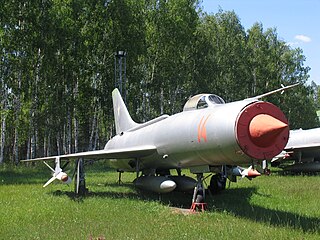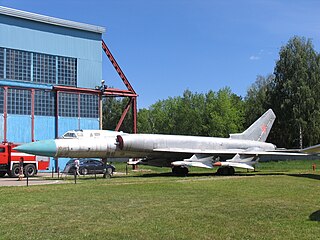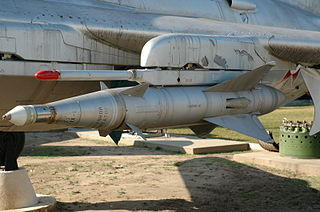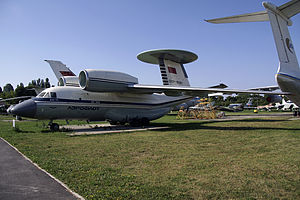
The Soviet Air Forces were one of the air forces of the Soviet Union. The other was the Soviet Air Defence Forces. The Air Forces were formed from components of the Imperial Russian Air Service in 1917, and faced their greatest test during World War II. The groups were also involved in the Korean War, and dissolved along with the Soviet Union itself in 1991–92. Former Soviet Air Forces' assets were subsequently divided into several air forces of former Soviet republics, including the new Russian Air Force. The "March of the Pilots" was its marching song.

The Mikoyan-Gurevich MiG-3 is a Soviet fighter-interceptor used during World War II. It was a development of the MiG-1 by the OKO of Zavod (Factory) No. 1 in Moscow to remedy problems found during the MiG-1's development and operations. It replaced the MiG-1 on the production line at Factory No. 1 on 20 December 1940 and was built in large numbers during 1941 before Factory No. 1 was converted to build the Ilyushin Il-2.

The Antonov An-72 is a Soviet transport aircraft, developed by Antonov. It was designed as a STOL transport and intended as a replacement for the Antonov An-26, but variants have found success as commercial freighters.

The Tupolev Tu-4 is a piston-engined Soviet strategic bomber that served the Soviet Air Force from the late 1940s to mid-1960s. The aircraft was a copy of the American Boeing B-29 Superfortress, having been reverse-engineered from seized aircraft that had made emergency landings in the USSR.

The Sukhoi Su-11 is an interceptor aircraft used by the Soviet Union during the Cold War.

The Myasishchev M-4 Molot was a four-engined strategic bomber designed by Vladimir Mikhailovich Myasishchev and manufactured by the Soviet Union in the 1950s to provide a Long Range Aviation bomber capable of attacking targets in North America.

The Soviet Air Defence Forces was the air defence branch of the Soviet Armed Forces.

Soviet Naval Aviation was the naval aviation arm of the Soviet Navy.

The Tupolev Tu-28 is a long-range interceptor aircraft introduced by the Soviet Union in the 1960s. The official designation was Tu-128, but this designation was less commonly used in the West. It was the largest and heaviest fighter ever in service.

The Yakovlev Yak-25 is a swept wing, turbojet-powered interceptor and reconnaissance aircraft built by Yakovlev and used by the Soviet Union.

The Kaliningrad K-5, also known as RS-1U or product ShM, was an early Soviet air-to-air missile.

The Tupolev Tu-14, was a Soviet twinjet light bomber derived from the Tupolev '73', the failed competitor to the Ilyushin Il-28 'Beagle'. It was used as a torpedo bomber by the mine-torpedo regiments of Soviet Naval Aviation between 1952–1959 and exported to the People's Republic of China.

The Yakovlev Yak-44 was a proposed twin-turboprop Airborne Early Warning (AEW) aircraft, resembling the United States Navy's E-2 Hawkeye, intended for use with the Soviet Navy's Ulyanovsk class supercarriers. Along with the aircraft carrier it would have flown from, the Yak-44 was cancelled after the demise of the Soviet Union. A full-scale mockup with foldable wings was built.

The Shaanxi Y-8 or Yunshuji-8 aircraft is a medium size medium range transport aircraft produced by Shaanxi Aircraft Corporation in China, based on the Soviet Antonov An-12. It has become one of China's most popular military and civilian transport/cargo aircraft, with many variants produced and exported. Although the An-12 is no longer made in Ukraine, the Chinese Y-8 continues to be upgraded and produced. An estimated 169 Y-8 aircraft had been built by 2010.

The Xi'an Y-7 is a twin turboprop transport/passenger aircraft built in China. It is based on the Soviet-designed Antonov An-24 series.

The Kamov Ka-31 is a military helicopter originally developed for the Soviet Navy and currently in service in Russia, China, and India in the naval airborne early warning and control role.
The Alekseyev I-212 was a twin-engined, jet fighter designed in the USSR in 1947 at OKB-21. It was a two-seat variant of the I-21 designed in response to a requirement for a very long-range fighter issued by the Voenno-Vozdushnye Sily (VVS),, in 1946. Intended as an escort fighter, it was also designed for use as a night fighter and reconnaissance aircraft. No prototype was built, although some parts may have begun building before the project was completed.
This is a glossary of acronyms and initials used for organisations in the Russian Federation and formerly the USSR. The Latin-alphabet names are phonetic representations of the Cyrillic originals, and variations are inevitable.

The 149th Mixed Aviation Division was an aviation division of the Russian Air Force.
Yefim Gordon is a Lithuanian aircraft photographer and author who specializes in Soviet aircraft and Russian aviation.




















